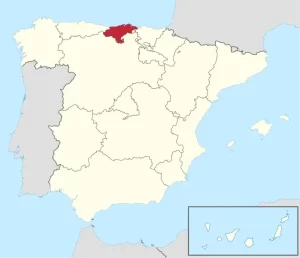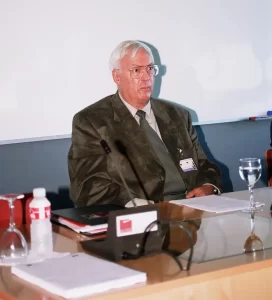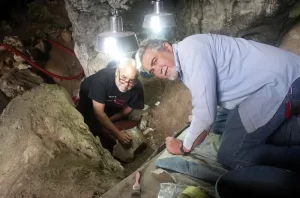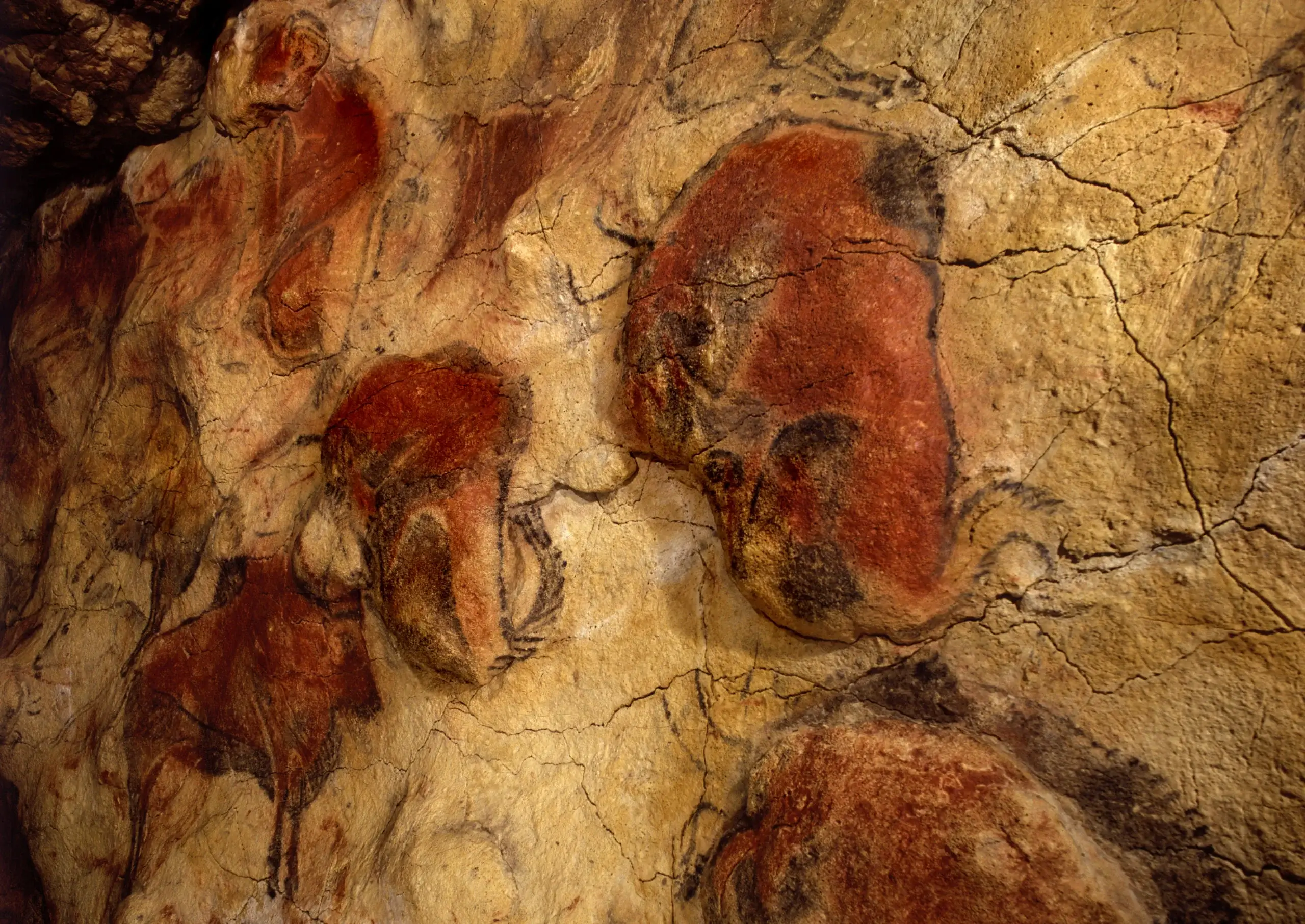Para leer en español oprime aquí.
The North American presence in the Spanish region of Cantabria has been evident since the beginning of the 20th century, and this presence was particularly significant in the second half of the century when young American researchers abundantly addressed different aspects of the prehistory of this area of Spain in their doctoral theses.
First of all, we have to talk about geographical location. The aforementioned Cantabrian region is located in the north of Spain, in a very rich and fertile space for archaeological sites and in caves decorated with Palaeolithic rock art declared a World Heritage Site by Unesco.

Region of Cantabria
In fact, one of those privileged territories is Cantabria, which, with little more than 5,000 square kilometers, could be considered to be an underground museum made up of geological cathedrals. In these cathedrals, human beings who lived during the last ice age tens of thousands of years ago, left an unrivaled, unique testimony of exceptional universal value on the walls and ceilings of prehistoric caves in the form of paintings and engravings, as well as cultural materials.
Since the discovery of the Altamira cave, Cantabria has become a world reference in prehistory, and it was the reason why researchers of different nationalities left their mark on this small Spanish enclave.
In the case of the United States, I will focus on four figures who, in my opinion, best represent the contribution of American research to the knowledge of Cantabrian prehistory.
We will start our tour in one of the most important archaeological sites in Europe, in the cave of El Castillo, in the town of Puente Viesgo. Discovered by Hermilio Alcalde del Río in 1903, its site has documented human occupations that exceed 150,000 years old, while inside there is one of the largest concentrations of Palaeolithic rock art.
During the excavations at El Castillo, directed by Hugo Obermaier between 1910 and 1914, with the patronage of Albert I of Monaco, we find the first American researcher, Nels Christian Nelson (1875-1964), whose most significant contribution was to establish sequence stratigraphy in the site, which shows the different moments of human occupation throughout the Paleolithic Age.
A doctorate from the University of California, in his doctoral thesis, a pioneer in its time for its archaeological methodology, he focused on the study of the shells of the San Francisco Bay. For years, Nelson had been curator of the prehistoric archeology department of the American Museum of Natural History in New York, in whose deposits are detailed photographic documentation, drawings, sediment samples, lithic industry (stone tools) and fauna collected by Nelson at El Castillo during the 1913 campaign.
Another of the renowned North American researchers who worked in Cantabria was George Grant MacCurdy (1863-1947), professor at Yale University and curator of the department of archeology and anthropology at the Yale Peabody Museum of Natural History between 1902 and 1931. He was a renowned prehistorian and author of such notable works as Human Origins and A Manual of Prehistory (1924) and president of the American Anthropological Association.
During his stay in Cantabria, MacCurdy was at the El Castillo cave site, as well as at the Altamira excavations, directed by Obermaier, and he had the opportunity to learn about the work of Jesús Carballo in the El Pendo cave.
Starting in the sixties, the presence of American researchers related to “New Archeology” was intense and fruitful, since it involved the introduction of new theoretical paradigms and modern methodologies in field work, situating regional prehistory at the forefront of Europe.

Leslie Gordon Freeman, Congress about Neanderthals. Museo de Altamira, 2004.
In this sense, Leslie Gordon Freeman (1935-2012) stands out for leaving a deep mark in Cantabria thanks to his studies in such emblematic caves as Altamira, El Castillo, El Pendo, El Juyo and Morín, among others, along with his inseparable colleague and friend, the illustrious regional researcher Joaquín González Echegaray (1930-2013).
Freeman arrived in Spain in the early sixties to participate in the excavations of Torralba and Ambrona (in the province of Soria), which were under the direction of Francis Clark Howell, paleontologist and anthropologist at the University of Chicago, and of which Freeman was a student and disciple.
From there, Freeman moved to Santander with the aim of studying the materials of the Mousterian culture (of the Neanderthals) deposited in the provincial museum of the Cantabrian capital. The result of these investigations was the doctoral thesis that he presented at the aforementioned University of Chicago in 1964, of which he was a professor until his retirement.
One of the most relevant excavations in which Freeman participated was the one carried out in Cueva Morín (Villanueva de Villaescusa), conducted together with Echegaray between 1966 and 1969.
No less remarkable were his interventions in the Juyo cave (Camargo, 1978-1997) and, in particular, Altamira (Santillana del Mar, 1980-1981), where he focused on the study and interpretation of the paintings and engravings of the famous ceiling of the polychromes identified and authenticated by Marcelino Sanz de Sautuola in 1879.
Both Freeman and Echegaray were the promoters of what is today the International Institute for Prehistoric Research of Cantabria, founded in 2004.
The most outstanding example, due to his long scientific career in Cantabria, is that of Lawrence Guy Straus. After completing his doctoral thesis on the Palaeolithic Age of the Cantabrian region, Straus held a position as Professor of Anthropology at the University of New Mexico, Albuquerque. He has also been editor of the Journal of Anthropological Research.
His greatest contribution to the knowledge of Cantabrian prehistory is linked to the Mirón cave (Ramales de la Victoria, 1996-2013), co-directing the excavations together with Manuel González Morales, professor of Prehistory at the University of Cantabria, and making this cave in a reference point of European prehistory to understand the customs of our Paleolithic ancestors.

Lawrence Guy Straus (right) in the El Mirón cave. Image: Universidad de Cantabria
One of the most publicized findings is the one that occurred in the summer of 2010, when Straus and Morales identified the first Magdalenian burial of the Iberian Peninsula. It was about a woman between 35 and 40 years old who lived 18,700 years ago and whose body was covered with ocher, which is why it is considered part of a complex funeral ritual. Hence, she is known as the “red lady” of El Mirón.
Having made this journey through regional prehistory following in the footsteps of these four researchers, I would like to conclude by pointing out that the US presence in the Cantabrian region exceeds the selection proposed in this article.
Suffice it to say, among others of note are Henry Fairfield Osborn, director of the American Museum of Natural History in New York; Sol Tax, Professor of Anthropology at the University of Chicago; Geoffrey Anderson Clark, a disciple of Freeman at the University of Chicago and a professor at Arizona State University in Tempe; Richard G. Klein, Professor of Anthropology and Evolutionary Biology at the University of Chicago; Margaret Conkey, Freeman’s disciple and professor at the University of California at Berkeley; Kathryn Cruz-Uribe, Freeman’s disciple and professor of Anthropology at Northern Arizona University.
Gonzalo Pedro Sánchez Eguren is an anthropologist, sociologist, and historian.





